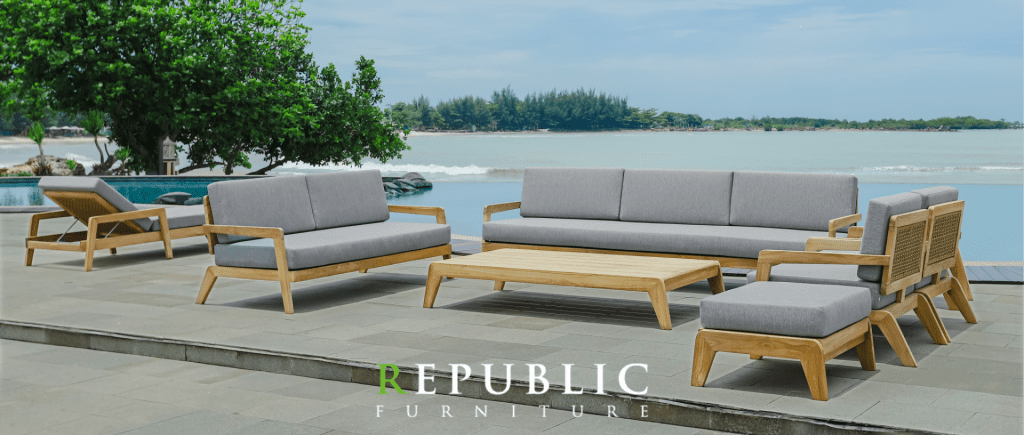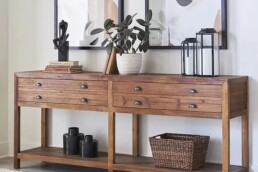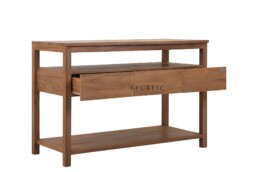Reproduction Furniture is created with inspiration and aims to replicate the style, design and manufacturing techniques referring to earlier historical periods which have high artistic taste values. Reproduction Furniture is made of traditional materials, with traditional craftsmanship techniques resembling old antique works. Its appearance tries to bring out the visual creation skills, charm and elegance of the past era, present again in this modern era.
Table of Contents
ToggleConcept of Reproduction Furniture
The concept of reproduction furniture has been around since ancient times and is not a new item anymore. This is due to the interest in reappearing past design styles that have their own beauty, wanting to bring back the nuances of the grandeur and opulence of past eras and finally manifesting them in reproduction furniture in custom.
Reproduction Furniture seeks to capture the essence and visual appeal of historical times. Skilled craftsmen try to make it happen by replicating it as perfectly as possible down to the details of the carved artwork. For this reason, they study and apply it to the manufacturing process, including the characteristics of design elements, construction techniques, and decorative features in certain eras, and make it happen in reproduction furniture works.
The process of making reproduction furniture requires a high level of expertise from the craftsmen, and cannot be done haphazardly. The carving workmanship, the joining process between parts to the coating process are all done with high-level techniques. The materials used were also the same as the materials used at that time, for example solid woods, veneers, gilding and upholstery fabrics were selected as closely as possible.
Types of Reproduction Furniture
There are many types of reproduction furniture covering various styles and periods. Here are some styles that are often made and are quite popular:
1. Georgian Reproduction Furniture
This type refers to its existence during the British royal era, especially the era of King George in England (1714-1820). This style has elegant features, intricate wood carvings, plus various classic elements to enhance its appearance.
2. Queen Anne Reproduction Furniture
Works in the early 18th century in England are characterized by showing elegance and refinement of design, appearing in simplicity of style and motifs, including simple curves but looking sweet and elegant.
3. Chippendale Reproduction Furniture
The name is the name of the cabinet maker Thomas Chippendale era (1718-1779), the style is characterized by exquisite craftsmanship plus ornate details in each of his works, including high-level intricate carvings, and Chinese-inspired designs.
4.Louis XVI Reproduction Furniture
The model, which was oriented towards the era of Louis XVI in power in France (1774-1792), has the characteristics of a neo-classical style, symmetrical design lines, straight lines and fine carvings, featuring motifs that were popular at that time.
5. Colonial Reproduction Furniture
This style was prevalent and popular in its era from the late 17th to early 19th centuries, featuring traditional carpentry techniques, producing works based on simplicity, solid construction and high functionality.
6. Federal Reproduction Furniture
The popular style of its time in the late 18th, early 19th centuries, is characterized by a neo-classical, elegant look including smooth surfaces, inspired by models of ancient Greece and Rome.
7. Regency Reproduction Furniture
The style that was popular in the early 19th century in England, featured works of neo-classical and romantic, luxurious in nature with extravagant details, bold designs, richly figured woods, and decorative accents.
8. Victorian Reproduction Furniture
This type was oriented towards the Victorian era (1837-1901), during which various styles emerged, characterized by luxury with various additional decorations, motifs, wood carvings and upholstery materials.
9. Art Deco Reproduction Furniture
Appeared in the 1920-1930s era, showing the characteristics of elegance and luxury in style, appearing with geometric shapes with a sleek design, made of high quality luxury materials.
10. Mid-century Reproduction Furniture
Creative creations revived the Mid-Century era in the mid-20th century (1940-1960) characterized by simplicity and functionality. Contemporary fresh aesthetic for its era.
 Skills should be have to make Reproduction Furniture
Skills should be have to make Reproduction Furniture
To make quality reproduction furniture, special expertise is needed to make the work, so that the results can meet expectations and successfully display elegant works according to the era of that era. The following factors are required:
1. Woodworking Skills
Expertise and expertise in manufacturing is clearly needed, including in terms of joinery, carving, turning, shaping and also finishing processes. In addition, he also has knowledge and experience in the use of woodworking tools, various workmanship techniques and knowledge of materials.
2. Design and Drafting
The ability to interpret, interpret and replicate historical designs is a crucial point. The ability to examine proportions, attention to detail, as well as capture the aesthetic charm of the whole. The ability to put existing drawing designs and blueprints into a tangible form of creation.
3. Historical Knowledge
In-depth knowledge of the different historical features and characteristics of each is very necessary, how each construction method, various elements of decoration and various styles are very important so that craftsmen are able to capture every essence of each period.
4. Research Skills
The ability to do a lot of research regarding the reproduction furniture to be made, using various media to add insight into knowledge of related matters, will be very useful as a brainstorming so that the work produced is in accordance with the essence.
5. Attention to Details
Making Reproduction Furniture requires a high level of accuracy and full attention to detail, because the nature of the work is to replicate something as closely as possible to the original. This includes attention to accurately replicate from the intricate designs, moldings, to decorative elements in the works of historic antiquity. The need for accuracy and precision in measurement, the manufacturing process to the completion of the final result of a work according to the original plan.
6. Material Selection and Knowledge
The selection of manufacturing materials including knowledge about this is an important aspect, in order to produce Reproduction Furniture with a high degree of resemblance to the original. The right material is one of the determining factors in order to produce quality identical work.
7. Patience and Perseverance
Making Reproduction Furniture is a process with a high level of precision and complexity, so it requires patience, perseverance, working with patience is a challenge in itself, to ensure the end result is of the quality expected.
8. Adaptation to Modern Techniques
The goal of Reproduction Furniture is to produce works of art like those of the past, but in the present work process it can adapt to modern techniques such as modern woodworking tools and other modern equipment so that the results can be according to plan with other advantages, namely producing high-durability products including their level of functionality.
9. Business and Communication Skills
If the results of reproduction furniture are used for commercial purposes, sold in local or international markets, then business skills are needed. communication and optimal use of the network network. This is to ensure the success of the sales process.
The process of making reproduction furniture requires a high level of expertise as well as quality materials, in order to properly imitate the designs of past styles. Adaptation using modern techniques is useful for improving quality, longer durability, so that it can be used for a long time, whatever the purpose of manufacture.
Reproduction furniture has become a separate industry with a high level of demand, so that it continues to develop into a professional industrial sector, with a clear market share. Therefore attention to quality and customer satisfaction is also the main focus of the entire process, a form of appreciation for past works in a modern form.



